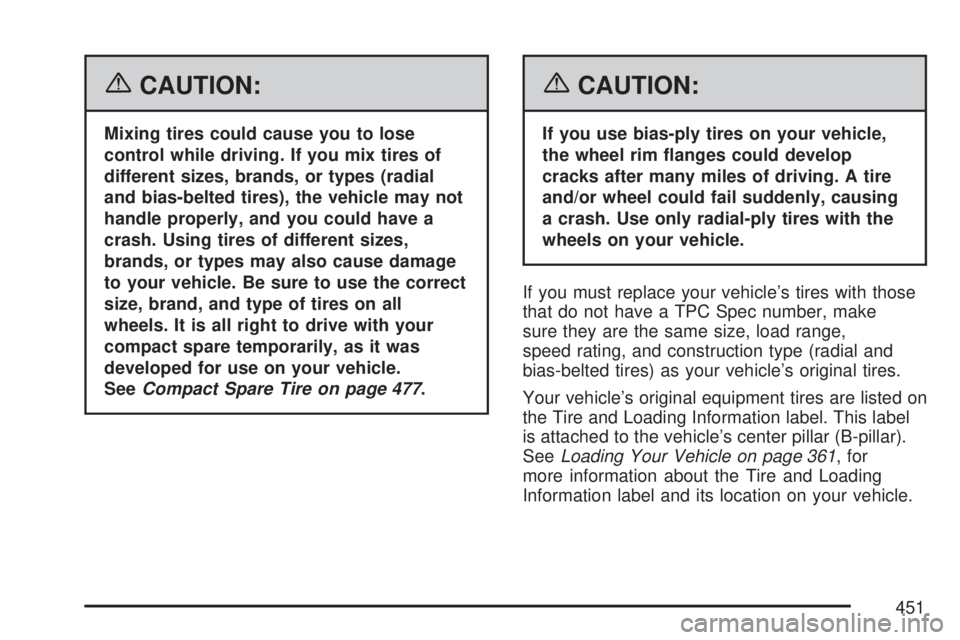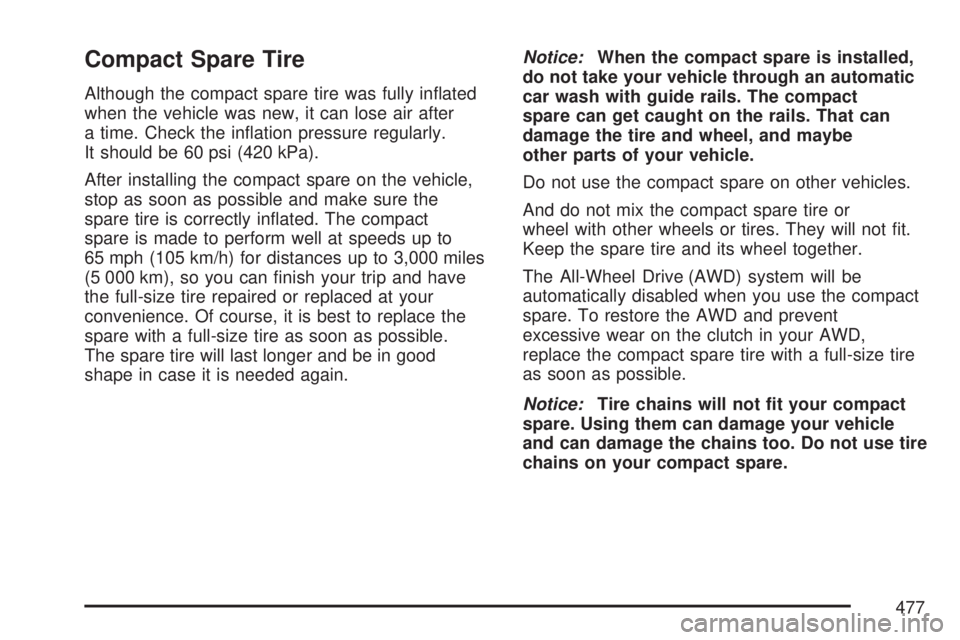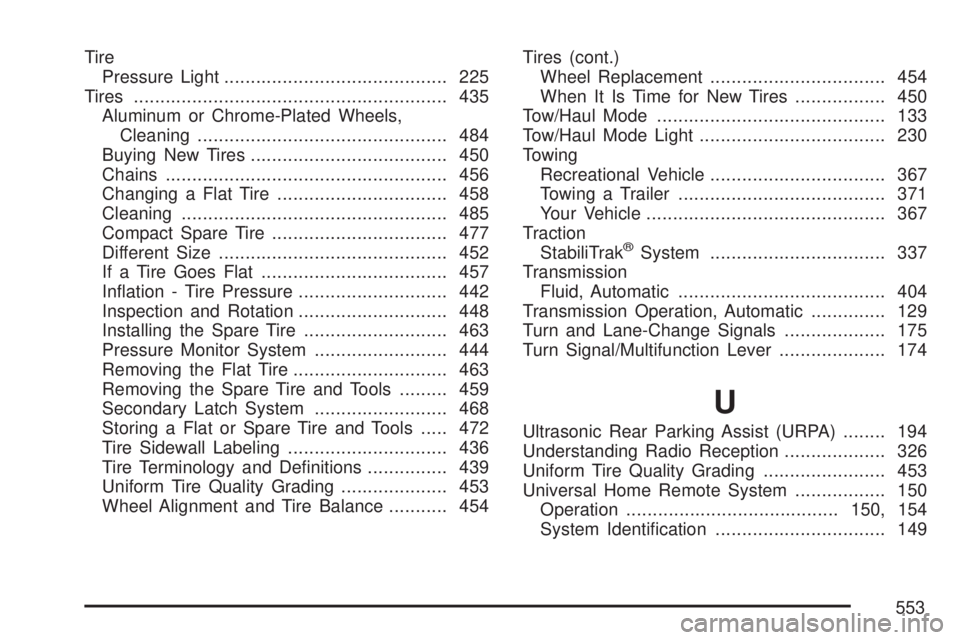Page 451 of 554

{CAUTION:
Mixing tires could cause you to lose
control while driving. If you mix tires of
different sizes, brands, or types (radial
and bias-belted tires), the vehicle may not
handle properly, and you could have a
crash. Using tires of different sizes,
brands, or types may also cause damage
to your vehicle. Be sure to use the correct
size, brand, and type of tires on all
wheels. It is all right to drive with your
compact spare temporarily, as it was
developed for use on your vehicle.
SeeCompact Spare Tire on page 477.
{CAUTION:
If you use bias-ply tires on your vehicle,
the wheel rim �anges could develop
cracks after many miles of driving. A tire
and/or wheel could fail suddenly, causing
a crash. Use only radial-ply tires with the
wheels on your vehicle.
If you must replace your vehicle’s tires with those
that do not have a TPC Spec number, make
sure they are the same size, load range,
speed rating, and construction type (radial and
bias-belted tires) as your vehicle’s original tires.
Your vehicle’s original equipment tires are listed on
the Tire and Loading Information label. This label
is attached to the vehicle’s center pillar (B-pillar).
SeeLoading Your Vehicle on page 361, for
more information about the Tire and Loading
Information label and its location on your vehicle.
451
Page 452 of 554
Different Size Tires and Wheels
If you add wheels or tires that are a different size
than your original equipment wheels and tires,
this could affect the way your vehicle performs,
including its braking, ride and handling
characteristics, stability, and resistance to rollover.
Additionally, if your vehicle has electronic
systems such as anti-lock brakes, rollover airbags,
traction control, and electronic stability control,
the performance of these systems can be affected.{CAUTION:
If you add different sized wheels, your
vehicle may not provide an acceptable
level of performance and safety if tires not
recommended for those wheels are
selected. You may increase the chance
that you will crash and suffer serious
injury. Only use GM speci�c wheel and
tire systems developed for your vehicle,
and have them properly installed by a
GM certi�ed technician.
SeeBuying New Tires on page 450and
Accessories and Modifications on page 385
for additional information.
452
Page 456 of 554
Tire Chains
{CAUTION:
Do not use tire chains. There is not
enough clearance. Tire chains used on a
vehicle without the proper amount of
clearance can cause damage to the
brakes, suspension or other vehicle parts.
The area damaged by the tire chains
could cause you to lose control of your
vehicle and you or others may be injured
in a crash.
CAUTION: (Continued)
CAUTION: (Continued)
Use another type of traction device only if
its manufacturer recommends it for use
on your vehicle and tire size combination
and road conditions. Follow that
manufacturer’s instructions. To help avoid
damage to your vehicle, drive slowly,
readjust or remove the device if it is
contacting your vehicle, and do not spin
your vehicle’s wheels. If you do �nd
traction devices that will �t, install them
on the front tires.
456
Page 461 of 554
1. Open the storage compartment door of the
convenience center that is nearest the
liftgate.
2. Move the carpet cutout that is located through
the hole of the storage compartment.
3. Attach the lug wrench into the hoist shaft.
4. Turn the lug wrench counterclockwise to lower
the spare tire to the ground. Continue turning
the wrench until the spare tire can be
pulled out from under the vehicle.
5. Tilt the retainer and slip it through the wheel
opening to remove the spare tire from the
cable.
6. Turn the wrench clockwise to raise the cable
back up after removing the spare tire.
Do not store a full-size or a �at road tire under
the vehicle. SeeStoring a Flat or Spare Tire
and Tools on page 472.
461
Page 474 of 554
Storing the Flat Tire
Notice:Storing the full-size �at tire in the
underbody hoist system can expose it to heat
from the exhaust system. This can damage
the tire and underbody hoist system. Do not
store the full-size �at tire in the underbody
hoist system.
1. Remove the cable package from the jack
storage area.
2. Remove the small center cap by tapping the
back of the cap with the extension of the
shaft, if the vehicle has aluminum wheels.
3. Put the �at tire in the rear storage area with
the valve stem pointing toward the rear of the
vehicle.4. Hook on end of the cable onto the outside
portion of the liftgate hinge opposite (B).
5. Pull the cable (A) through the door striker (E),
the center of the wheel (D), and the plastic
spare tire heat shield (C), as shown.
474
Page 476 of 554
Storing the Tools
A. Tool Bag
B. Wing Bolt
C. JackPut back all tools as they were stored in the jack
storage compartment and put the compartment
cover back on.
1. Make that the bottom of the jack is facing
toward you.
2. Turn the jack (C) on its side and place it down
on the holding bracket.
3. Reinstall the wing bolt (B) by turning it
clockwise.
4. To replace the cover, line up the tabs on the
bottom of the cover with the slots in the cover
opening. Push the cover in place, insuring
that the upper front and rear tabs are in
the opening and push the cover closed. Make
sure that the center latch is fully engaged.
This secures the cover in place.
Store the center cap or the plastic bolt-on wheel
covers until a full size tire is put back on the
vehicle. When you replace the compact spare with
a full-size tire, reinstall the bolt-on wheel covers
or the center cap. Hand-tighten them over
the wheel nuts, using the lug wrench.
476
Page 477 of 554

Compact Spare Tire
Although the compact spare tire was fully in�ated
when the vehicle was new, it can lose air after
a time. Check the in�ation pressure regularly.
It should be 60 psi (420 kPa).
After installing the compact spare on the vehicle,
stop as soon as possible and make sure the
spare tire is correctly in�ated. The compact
spare is made to perform well at speeds up to
65 mph (105 km/h) for distances up to 3,000 miles
(5 000 km), so you can �nish your trip and have
the full-size tire repaired or replaced at your
convenience. Of course, it is best to replace the
spare with a full-size tire as soon as possible.
The spare tire will last longer and be in good
shape in case it is needed again.Notice:When the compact spare is installed,
do not take your vehicle through an automatic
car wash with guide rails. The compact
spare can get caught on the rails. That can
damage the tire and wheel, and maybe
other parts of your vehicle.
Do not use the compact spare on other vehicles.
And do not mix the compact spare tire or
wheel with other wheels or tires. They will not �t.
Keep the spare tire and its wheel together.
The All-Wheel Drive (AWD) system will be
automatically disabled when you use the compact
spare. To restore the AWD and prevent
excessive wear on the clutch in your AWD,
replace the compact spare tire with a full-size tire
as soon as possible.
Notice:Tire chains will not �t your compact
spare. Using them can damage your vehicle
and can damage the chains too. Do not use tire
chains on your compact spare.
477
Page 553 of 554

Tire
Pressure Light.......................................... 225
Tires........................................................... 435
Aluminum or Chrome-Plated Wheels,
Cleaning............................................... 484
Buying New Tires..................................... 450
Chains..................................................... 456
Changing a Flat Tire................................ 458
Cleaning.................................................. 485
Compact Spare Tire................................. 477
Different Size........................................... 452
If a Tire Goes Flat................................... 457
In�ation - Tire Pressure............................ 442
Inspection and Rotation............................ 448
Installing the Spare Tire........................... 463
Pressure Monitor System......................... 444
Removing the Flat Tire............................. 463
Removing the Spare Tire and Tools......... 459
Secondary Latch System......................... 468
Storing a Flat or Spare Tire and Tools..... 472
Tire Sidewall Labeling.............................. 436
Tire Terminology and De�nitions............... 439
Uniform Tire Quality Grading.................... 453
Wheel Alignment and Tire Balance........... 454Tires (cont.)
Wheel Replacement................................. 454
When It Is Time for New Tires................. 450
Tow/Haul Mode........................................... 133
Tow/Haul Mode Light................................... 230
Towing
Recreational Vehicle................................. 367
Towing a Trailer....................................... 371
Your Vehicle............................................. 367
Traction
StabiliTrak
®System................................. 337
Transmission
Fluid, Automatic....................................... 404
Transmission Operation, Automatic.............. 129
Turn and Lane-Change Signals................... 175
Turn Signal/Multifunction Lever.................... 174
U
Ultrasonic Rear Parking Assist (URPA)........ 194
Understanding Radio Reception................... 326
Uniform Tire Quality Grading....................... 453
Universal Home Remote System................. 150
Operation........................................150, 154
System Identi�cation................................ 149
553